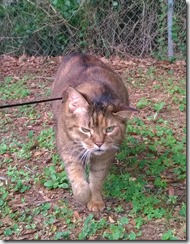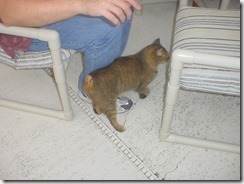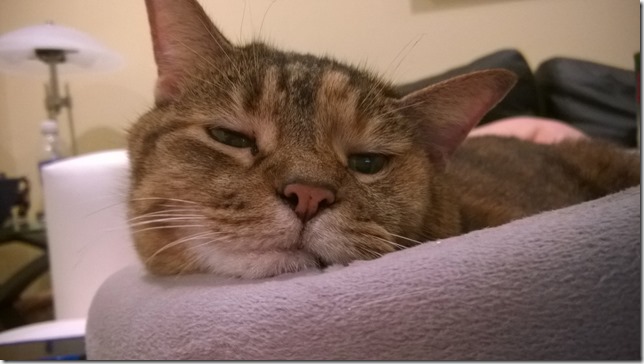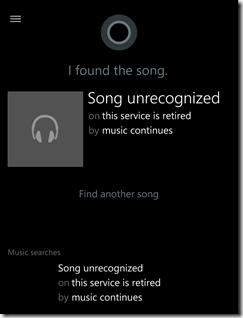It’s been a few weeks now since I’ve become petless. Last night I had a browse on the website of my local SPCA, which was sad – reading the stories of how these cats came to the shelter. Then I followed that up with a browse of my county animal control website, which was sadder in that the pets didn’t really have backstories, just how old the cat was and how long they’d been at the facility. I concluded with browsing the “lost pets”, which left me rather broken, because these cats had no story at all and only a single portrait taken in their arrival carrier, looking despondent and/or scared to death.
Part of the reason the “lost pets” section affected me so much was that I have a personal experience with it, which reminded me that I have yet to write my tribute to my lost companion. So without further delay, here is her story.
On Halloween of 2005, I went outside on my way to the neighbor’s house for a small holiday get-together. Just outside, in the driveway, was a cat. My neighborhood has many stray cats running around, so it wasn’t anything too unusual. I squatted down and called to the visitor and to my surprise, she came running right over and pressed against me. None of the other cats have ever been interested in attention before, so I found this strange. She let me pick her up, so I did and carried her across the street to show my (now ex-)wife. A dog that was at the party scared the cat out of my arms and I just shrugged the whole incident off.


The next day, my ex tells me the cat is now hanging around at the house. I wasn’t interested in another cat, we got one for free when we bought the house. But unfortunately, the ex had fed the new cat already, so I suppose she’s ours now.
We made plans to get her all caught up on her shots before we brought her into the house with the other cat. I made the vet appointment for later in the week. However, the next day, the new cat stopped coming around. The food went untouched for a couple of days and my ex started getting worried. I was less worried, thinking the cat had just gone back to her original family, or someone else adopted her and took her inside without the same level of preparations we were making.
The ex couldn’t be talked out of this, so she started going out and looking for the cat and talking to people she met, asking if they’d seen a cat around that had no tail. A couple more days of this and someone tipped her off that a house at the end of the street traps the neighborhood strays and turns them in to animal control. The ex calls animal control and asks about the tailless cat. Unsurprisingly, they are of no help on the phone and say we have to come to them to find out if the cat is there. So that becomes the priority for the next day.
 We arrive at the animal control shelter and they take us to the incoming cages. In these long cages are numbers of cats. We see the first cage, not there. The next cage, not there, just some kittens climbing the chain link. The next cage, not there. We get to the last cage (the one I assume is the last stop before the back room) and call her hastily-chosen name, “Rump”, and one cat, in the back of the cage, gets up and quickly trots to the front, shying away from her hissing companions.
We arrive at the animal control shelter and they take us to the incoming cages. In these long cages are numbers of cats. We see the first cage, not there. The next cage, not there, just some kittens climbing the chain link. The next cage, not there. We get to the last cage (the one I assume is the last stop before the back room) and call her hastily-chosen name, “Rump”, and one cat, in the back of the cage, gets up and quickly trots to the front, shying away from her hissing companions.
To say we were happy is quite an understatement. To look back and consider the situation, it was really miraculous – that we got there just in time to prevent Rump from being euthanized, that Rump recognized us immediately after only spending a couple of days with us, and that Rump knew we were there to get her.
 We were then shown into an office where an officer discussed the case with us. The officer asked if Rump was our cat. We said, no, she’s a stray, but we have a vet appointment for her. The officer told us that we can’t adopt her because she’s feral. This perplexed us. How did they make that determination? Apparently, Rump was not very pleasant with the impounding officer. Her intake photo (the one that ends up on “lost pets”) showed her screaming at the camera through a cage. The ex indignantly told the officer that’s how any cat would feel if she was being manhandled by a stranger. I tried to be a bit more diplomatic and asked if there was any other way we could adopt her. There was no adoption route for Rump, but we could claim her as our pet and we would have to pay fines and fees for the impoundment. We would have to provide proof of vaccinations and neutering. Additionally, I would have to attend a “responsible pet owner” education class. I agreed to all of it.
We were then shown into an office where an officer discussed the case with us. The officer asked if Rump was our cat. We said, no, she’s a stray, but we have a vet appointment for her. The officer told us that we can’t adopt her because she’s feral. This perplexed us. How did they make that determination? Apparently, Rump was not very pleasant with the impounding officer. Her intake photo (the one that ends up on “lost pets”) showed her screaming at the camera through a cage. The ex indignantly told the officer that’s how any cat would feel if she was being manhandled by a stranger. I tried to be a bit more diplomatic and asked if there was any other way we could adopt her. There was no adoption route for Rump, but we could claim her as our pet and we would have to pay fines and fees for the impoundment. We would have to provide proof of vaccinations and neutering. Additionally, I would have to attend a “responsible pet owner” education class. I agreed to all of it.
 I signed a lot of paperwork and paid a fair amount of money to release Rump from prison, then it was off to the vet. As it turns out, the vet appointment I had made earlier was that actual day.
I signed a lot of paperwork and paid a fair amount of money to release Rump from prison, then it was off to the vet. As it turns out, the vet appointment I had made earlier was that actual day.
I found out Rump was already spayed and she got her shots, which kind of doped her up for the rest of the day. But she was now allowed inside and was given a soft bed to sleep in, closed in on the lanai. This was her space for a while until the vaccinations settled in and also until she got used to seeing our other cat.
 The existing cat, Bubbles, was never very fond of Rump, and the feeling was mutual. Rump would stalk Bubbles throughout the house and worst of all, when she was in the litter box. This went on for a very long time, despite the few times where they would actually tolerate each other enough to be on the bed at the same time.
The existing cat, Bubbles, was never very fond of Rump, and the feeling was mutual. Rump would stalk Bubbles throughout the house and worst of all, when she was in the litter box. This went on for a very long time, despite the few times where they would actually tolerate each other enough to be on the bed at the same time.
Rump’s experience with being a stray, combined with sharing the house with another cat caused her to do a lot of stress eating. If there was food, she was going to eat it. Bubbles used to be fine with leaving dry food down all day, but with Rump in the house too, Rump would eat it all. I assume Rump was constantly in fear that there wouldn’t be another meal or that Bubbles would eat it all, leaving nothing for her. It was impossible to convince her otherwise. As you would expect, Rump became very plump.
Time went on, and my ex moved out and moved on with her life, and Bubbles eventually became old and had to be put to sleep, leaving Rump as the sole queen of the house. Without Bubbles, her diet became normal again and she went down to a less obese weight, but remained flappy.
 Rump was always a dog-like cat, as most Manx cats are reported to be. One of her most distinct behaviors was leaning her haunch against your leg, like a dog. She was a rough-and-tumble cat, playing rough was enjoyable for her. She could get mad at you, but would make up with you the very next second.
Rump was always a dog-like cat, as most Manx cats are reported to be. One of her most distinct behaviors was leaning her haunch against your leg, like a dog. She was a rough-and-tumble cat, playing rough was enjoyable for her. She could get mad at you, but would make up with you the very next second.
Rump loved everyone she ever met. She was very kind, friendly, and outgoing. She enjoyed being the center of attention; the more people that were around, the more she would show off – racing in and out of the room or leaping between countertops to get attention.
Rump was a loving companion for 13 years and had a personality that showed two cat-skeptics that cats can be affectionate and trusting instead of aloof and brooding. All in all, a good life for everyone involved.

I dig a well / I dig it deep / And for my only love / I plant a cedar tree / The best / The best we ever had
Cedar Tree – Indigo Girls











